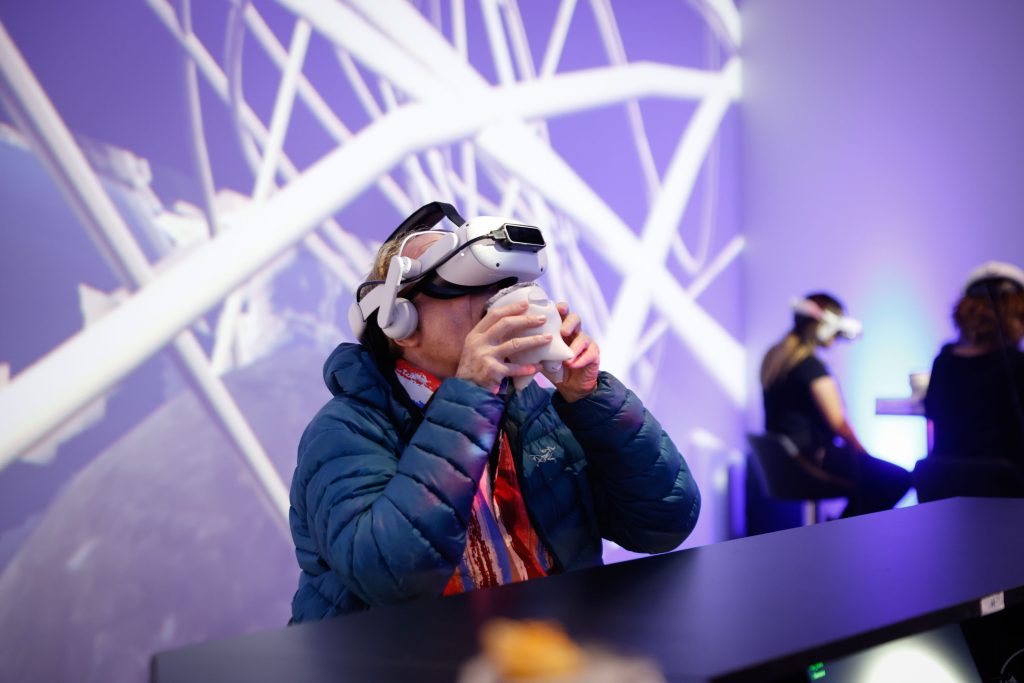Link About It: This Week’s Picks
A pioneering Black composer, a space pod sculpture, the culture represented in cuisine and more from around the internet

NYC Middle Schoolers Write the Only Children’s Book About Black Composer Florence Price
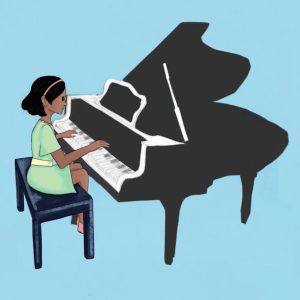 At Special Music School, NYC’s only music-focused K-12 public school, English teacher Shannon Potts assigned her sixth, seventh and eighth grade classes to study Florence Price, the first Black woman to have her music played by a major American orchestra. But as her students learned more about Price—whose contributions have become largely erased from historical and cultural memory—they realized there was little written about her, and no books at all aimed at kids, so Potts suggested they create their own. After 45 students wrote and illustrated Price’s biography, their book Who is Florence Price? found its way from the school to G Schirmer, the company that publishes Price’s music. The president of the company, Robert Thompson, was so floored by the children’s work, he agreed to publish it. The book is currently available for purchase with all royalties going to the non-profit organization Kaufman Music Center. Read more about the kids behind this inspiring work at NPR.
At Special Music School, NYC’s only music-focused K-12 public school, English teacher Shannon Potts assigned her sixth, seventh and eighth grade classes to study Florence Price, the first Black woman to have her music played by a major American orchestra. But as her students learned more about Price—whose contributions have become largely erased from historical and cultural memory—they realized there was little written about her, and no books at all aimed at kids, so Potts suggested they create their own. After 45 students wrote and illustrated Price’s biography, their book Who is Florence Price? found its way from the school to G Schirmer, the company that publishes Price’s music. The president of the company, Robert Thompson, was so floored by the children’s work, he agreed to publish it. The book is currently available for purchase with all royalties going to the non-profit organization Kaufman Music Center. Read more about the kids behind this inspiring work at NPR.
Image courtesy of Special Music School + Kaufman Music Center
Artist Michael Kagan’s Space Capsule Sculpture Floats in Miami
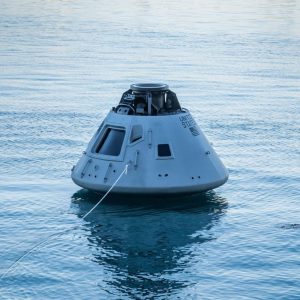 Bobbing along in the water of Miami’s Biscayne Bay, Brooklyn-based fine artist Michael Kagan’s 400-pound space capsule sculpture looks as if it has just dropped down from an astronomical adventure above. Presented by New York’s Half Gallery, the work strikes a mesmerizing balance of realism and fantasy. This isn’t Kagan’s first foray into space-exploration art. As Artnet reports, he “has long made paintings of astronauts, but sculptures are a new extension of his practice. He unveiled his first one, a life-size bronze astronaut based on a figure from a painting, at the amfAR Gala in Cannes in July.” Kagan currently has another astronaut sculpture at Art Basel Miami Beach. Read more about the artist’s celestial fascination at Artnet.
Bobbing along in the water of Miami’s Biscayne Bay, Brooklyn-based fine artist Michael Kagan’s 400-pound space capsule sculpture looks as if it has just dropped down from an astronomical adventure above. Presented by New York’s Half Gallery, the work strikes a mesmerizing balance of realism and fantasy. This isn’t Kagan’s first foray into space-exploration art. As Artnet reports, he “has long made paintings of astronauts, but sculptures are a new extension of his practice. He unveiled his first one, a life-size bronze astronaut based on a figure from a painting, at the amfAR Gala in Cannes in July.” Kagan currently has another astronaut sculpture at Art Basel Miami Beach. Read more about the artist’s celestial fascination at Artnet.
Michael Kagan’s “APOLLO 2021” (2021), photo courtesy of the artist and Half Gallery
California’s Bristlecones are the Oldest Recorded Trees in the World
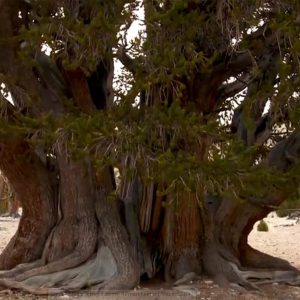 Located in California’s Inyo National Forest, the most ancient tree on record—a bristlecone pine named ‘Methuselah’—is over 4,800 years old. Dendrochronologists (researchers who study the science of dating tree rings) discovered bristlecones are some of the oldest individual trees by taking core samples from trunks, which indicate the tree’s chemical, climate and growth history. This method is especially fruitful for future planning. “What we’re seeing increasingly is that a lot of the climate events that we are experiencing and living through right now have no precedent in the paleoclimate record,” says researcher Andy Bunn. Studying bristlecones—which have survived throughout the California mountain’s harsh climate—can offer scientists insight on how to best approach current environmental conditions and conceive of more enduring, future ones. Learn more about these pines and their lasting strength at CBS.
Located in California’s Inyo National Forest, the most ancient tree on record—a bristlecone pine named ‘Methuselah’—is over 4,800 years old. Dendrochronologists (researchers who study the science of dating tree rings) discovered bristlecones are some of the oldest individual trees by taking core samples from trunks, which indicate the tree’s chemical, climate and growth history. This method is especially fruitful for future planning. “What we’re seeing increasingly is that a lot of the climate events that we are experiencing and living through right now have no precedent in the paleoclimate record,” says researcher Andy Bunn. Studying bristlecones—which have survived throughout the California mountain’s harsh climate—can offer scientists insight on how to best approach current environmental conditions and conceive of more enduring, future ones. Learn more about these pines and their lasting strength at CBS.
Image courtesy of CBS News
Food Writer Mayukh Sen Reframes Cuisine as Cultural Windows
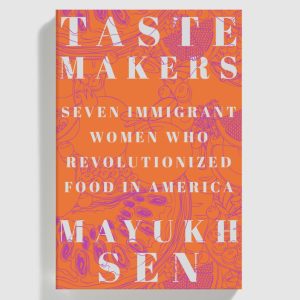 Mayukh Sen writes about food and its relation to cultural symbols through a decolonialized and anticapitalist perspective. In his recently released, debut book, Taste Makers: Seven Immigrant Women Who Revolutionized Food in America, he does so by crafting profiles on overlooked chefs and cooks in order to rectify what he calls the “cultural amnesia” that erased them from history. “Who has to take on the burden of cooking and what cultural rules made them do so? Who has to cook so that others can survive? What I’ve tried to reflect in my work is the truth that food is much more than an object for consumption. It is a window into so many imbalances within American society,” Sen tells MOLD. Find more insight in the interview which delves into Sen’s thoughts on the future of food writing, how to be more receptive to non-Eurocentric narratives about taste and more at MOLD.
Mayukh Sen writes about food and its relation to cultural symbols through a decolonialized and anticapitalist perspective. In his recently released, debut book, Taste Makers: Seven Immigrant Women Who Revolutionized Food in America, he does so by crafting profiles on overlooked chefs and cooks in order to rectify what he calls the “cultural amnesia” that erased them from history. “Who has to take on the burden of cooking and what cultural rules made them do so? Who has to cook so that others can survive? What I’ve tried to reflect in my work is the truth that food is much more than an object for consumption. It is a window into so many imbalances within American society,” Sen tells MOLD. Find more insight in the interview which delves into Sen’s thoughts on the future of food writing, how to be more receptive to non-Eurocentric narratives about taste and more at MOLD.
Image courtesy of Jake Sigl/Mold Magazine
Scientists Created a Regenerating Bacterial Ink for 3D Printers
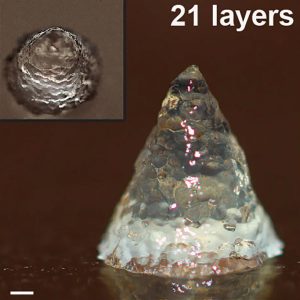 A new study published in the journal Nature Communications revealed that scientists created an ink from the toxic microbe E coli. These researchers found that when growing and feeding E coli bacteria, it secreted an ink made of living cells, which they then they used to plug into 3D printers. This project, while still underway, holds greater implications with regard to the future of sustainable, self-producing buildings—on Earth and in space. Because the living material is self-generating, scientists are hoping to use this research to build autonomous, renewable infrastructures that can adapt to their environments—even those in space, where resources are scarce. “Imagine creating buildings that heal themselves,” says one of the authors of the research, Dr Joshi. The future of this research may still be uncertain, but it’s clear that living materials are full of hopeful potential. Learn more about this at The New York Times.
A new study published in the journal Nature Communications revealed that scientists created an ink from the toxic microbe E coli. These researchers found that when growing and feeding E coli bacteria, it secreted an ink made of living cells, which they then they used to plug into 3D printers. This project, while still underway, holds greater implications with regard to the future of sustainable, self-producing buildings—on Earth and in space. Because the living material is self-generating, scientists are hoping to use this research to build autonomous, renewable infrastructures that can adapt to their environments—even those in space, where resources are scarce. “Imagine creating buildings that heal themselves,” says one of the authors of the research, Dr Joshi. The future of this research may still be uncertain, but it’s clear that living materials are full of hopeful potential. Learn more about this at The New York Times.
Image courtesy of Duraj-Thatte et al./Nature Communications
First-Ever Realistic Humanoid Robot Writes Dante-Inspired Poems
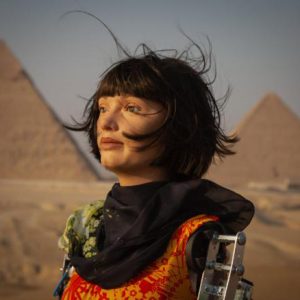 Last week at the University of Oxford’s Ashmolean Museum, Aidan Miller unveiled the world’s first highly-realistic humanoid robot artist, Ai-Da, who wrote poetry inspired by Dante’s Divine Comedy. Using algorithms programmed with Dante’s epic, the robot integrated his speech patterns alongside her lexicon of vocabulary to produce her own deeply moving work. The poetry debuted in conjunction with Eyes Wide Shut, an exhibit on surveillance, which was created by the robot as a response to an incident in Egypt when Ai-Da was detained by security. “The Ai-Da project was developed to address the debate over the ethics of further developing AI to imitate humans and human behavior,” Miller says. But in this undertaking, the creator realized that the project isn’t about finding the human in AI so much as locating how robotic humans are. He continues, “Ai-Da allows us to gain a new insight into our own patterns and our own habits, as we see her imitate them right in front of us.” Read more this enlightening project at CNN.
Last week at the University of Oxford’s Ashmolean Museum, Aidan Miller unveiled the world’s first highly-realistic humanoid robot artist, Ai-Da, who wrote poetry inspired by Dante’s Divine Comedy. Using algorithms programmed with Dante’s epic, the robot integrated his speech patterns alongside her lexicon of vocabulary to produce her own deeply moving work. The poetry debuted in conjunction with Eyes Wide Shut, an exhibit on surveillance, which was created by the robot as a response to an incident in Egypt when Ai-Da was detained by security. “The Ai-Da project was developed to address the debate over the ethics of further developing AI to imitate humans and human behavior,” Miller says. But in this undertaking, the creator realized that the project isn’t about finding the human in AI so much as locating how robotic humans are. He continues, “Ai-Da allows us to gain a new insight into our own patterns and our own habits, as we see her imitate them right in front of us.” Read more this enlightening project at CNN.
Image courtesy of Sima Diab/Getty Images
Link About It is our filtered look at the web, shared daily in Link and on social media, and rounded up every Saturday morning. Hero image of Michael Kagan’s “APOLLO 2021” (2021), photo courtesy of the artist and Half Gallery


